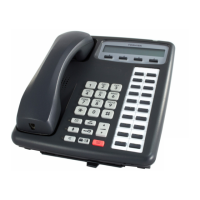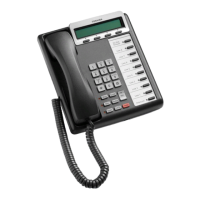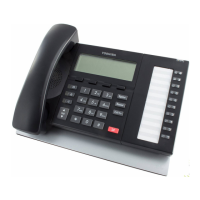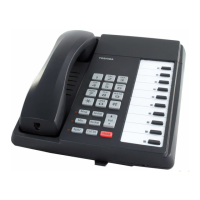DK40 Universal Slot PCBs
RBSU/RBSS ISDN Basic Rate Interface Unit
3-44
Strata DK40 I&M Manual Spring 1999
Refer to the Strata DK40 Programming Manual or DK Library CD-Rom for more details.
RBSU/RBSS
ISDN Basic Rate Interface Unit
System:
DK40 (Expansion KSU Only)
Circuits per PCB:
2 circuits (2B + D each circuit)
Interfaces with:
ISDN BRI S/T when connected to the Public Network or a BRI
S-type, TE or TA devices when connecting to ISDN station
equipment
Compatible Slot(s):
slots 15 ~ 18
Older Version(s):
None
The Strata DK40 Expansion KSU only, will support the RBSU/RBSS interface unit.
RBSU/RBSS switches, jumpers, and connectors are shown in Figures 3-26 and 3-27 on
Pages 3-48 and 3-49 and described in Table 3-14 on Page 50.
LEDs on the RBSU/RBSS show a continuous status of RBSU/RBSS operation. Refer to
Table 3-15 on Page 53 for a list of each LED’s status.
Overview
The RBSU and RBSS PCBs provide the Basic Rate Interface (BRI) circuits for the DK40
Expansion KSU. The RBSU is the main plug-in PCB and RBSS is an optional PCB that
plugs onto the RBSU. Each PCB provides two ISDN BRI circuits. Each BRI circuit provides
2 B-channels + 1D channel for voice/data/video communications. An REBU PCB is a piggy-
back PCB that plugs onto the RBSU and provides basic functions for RBSU/RBSS circuits so
it must always be installed on the RBSU.
RBSU circuits are four-wire S/T type circuits and connect to the Public Switched Telephone
Network (PSTN) BRI lines using an Network Terminator unit (NT1); or, on the station side,
they can connect to ISDN Terminal Equipment (TE)
TE devices include any ISDN device (telephone, fax, computer) that connects directly to S/T
ISDN BRI circuits. TA devices match the protocol of non-ISDN devices (telephone, fax,
computer) to the protocol of S/T ISDN BRI circuits.
The RBSU circuits can be configured two ways:
◆ As BRI – TE - Exchange Line Connection
◆ As BRI – NT - S-Bus
The RBSU connection options (BRI line or ISDN TE/TA devices) are selected in DK40
customer database programming and option switches located on the RBSU.
The network BRI line connection is a point-to-point connection, which means that the
network BRI line can only be connected to one RBSU circuit via the NT1 (T-reference point).
RBSS circuits connect directly to S-type TE or TA ISDN devices only. They do not support
BRI-TE telephone network BRI line connections, and work in “Point-to-Multipoint” mode
only.
The RBSU and/or RBSS circuit that connects to the DK station side, (BRI-NT, S-reference
point) allows direct connection of multiple ISDN (TE-1 or TA) devices. The S point of the
RBSU/RBSS supports the Toshiba DK passive bus, also known as point-to-multipoint
connection. The terminal-side (S-point) of the RBSU/RBSS BRI circuit can have parallel
connections of up to eight TEs or TAs maximum.
When multiple TE and TA devices are installed on a single RBSU/RBSS BRI circuit, the
devices must share, or contend for, that circuit’s two B-channels. That is to say, a maximum
of two simultaneous voice and/or data calls are allowed between both devices connected to

